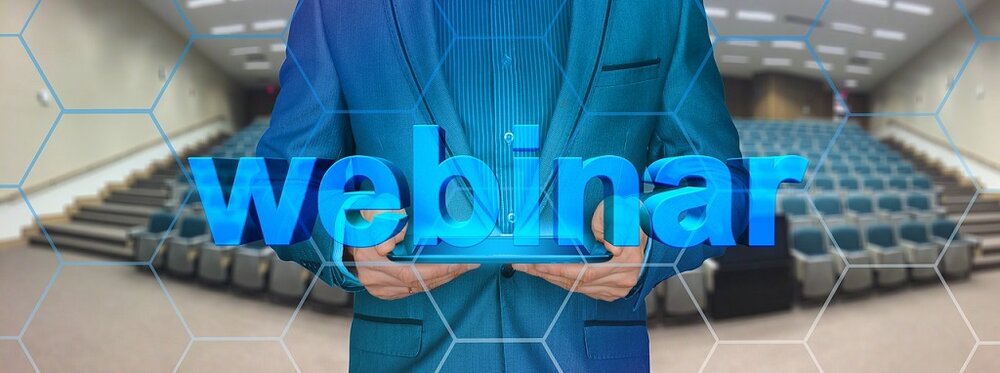Don’t fill those seats, just log in! [Image: Pixabay]
Yes, we’ll primarily remember 2020 as the Year of Pandemic, but it’s quickly taking on another face: the Year of the 3D Printing Webinar.
As face-to-face gatherings of any size — much less the tens of thousands attracted to large 3D printing conferences — are impossible to hold responsibly during this novel coronavirus outbreak, many industry events have gone digital.
Digital Events
The 3D printing industry certainly isn’t unique in this aspect, as terms like “Zoomers” are increasingly bandied about to refer to this new WFH (that’s “work from home”) lifestyle keeps us all housebound during business hours, connected virtually. Many events moved from the physical world to the virtual, as digital conferencing platforms like Zoom, WebEx, Microsoft Teams, Google Hangouts, Remo, and Skype — and those are just the ones I’ve personally been using so far — have taken center stage away from…you know, actual stages.
Some larger events have gone digital, moving their day-long programming to all-day virtual conferencing. This is nice as it offers both the familiarity of anticipated programming and the comforts of home. While at a physical conference, choosing between sessions can mean puttering about the hall during those slots that aren’t relevant to your area of interest, when it’s all virtual that helps block out the day; tune in from 11-noon, maybe, for a keynote of interest, then grab some lunch and get some work done before clicking back over in the late afternoon.
But more than digital conferencing with full schedules, there’s a major wave of that mainstay briefer event: the webinar.
Rise of the Webinar
Ah, the webinar.
A typically one-hour-long virtual presentation on a single topic, often used to inform about a particular product or explain a new tech introduction, these are increasingly coming into play in 3D printing not to take the place of physical events, but to spread information and broaden important discussions.
With 3D printing so in the public eye right now as stop-gap supply chain solutions for PPE and other necessary products are being 3D printed around the world, this industry is particularly shining for such e-gatherings.
This week, Fabbaloo worked with EOS North America to present a webinar called “COVID-19: A Tipping Point For Additive Manufacturing.” I had the pleasure of moderating this conversation with two industry experts from EOS North America, and it, along with other webinars I’ve recently moderated outside the scope of my work with Fabbaloo, has led to some additional food for thought.
My inbox, like yours I’m sure, has been increasingly full of webinar invitations. Many of these are the sort of conversation we had with EOS: an expert-driven discussion of additive manufacturing during crisis. Increasingly, though, we’re seeing something different as more and more 3D printer manufacturers begin to offer webinar series.
Some of these focus on their specific technologies, offering the kinds of insights we might have seen at sponsored speaker sessions during traditional conferences set to take place around now. Others are series wherein the host company brings in outside guests for each subsequent webinar, which inherently broadens the conversation. Still others are dedicated to different aspects of technologies; the differences, benefits, and challenges of, say, different metal 3D printing processes (e.g., this week let’s talk DMLS, next week binder jetting).
I’d previously been somewhat lukewarm to webinars. They could be helpful, sure, when discussing a relevant or hot topic. But they tended to be a bit of an inconvenient convenience; while virtual attendance opens up the possibility to join simply because it takes out the time-consuming aspect of travel even to area events, they still are generally held during the workday. In business-as-normal operations, it can be tricky sometimes to have a Wednesday mid-afternoon hour free to tune in.
But now everything is a bit topsy-turvy as the new normal, and there’s no chance of travel. While it’s great to have more time in my office — writing is, after all, probably the most important aspect of all the work we do here, and having time to actually write is helpful — I know I’m not alone in missing the spring events calendar.
Webinars are offering a fantastic sort of balance between zero travel and still dedicating a full day (or two+) to virtual programming. I can do an hour here or there to tune in to catch up with companies’ progress, to check in on experts’ thoughts on what this all might mean for manufacturing.
And as more people are realizing that, we’re likely to just see more and more webinars continue to come to the forefront.
There’s still some work to do to hammer out some issues — who’s moderating the conversation, how do you strike the right attendee interaction balance, how do you keep to one topic when so many others pop up, how do you choose the right topic and the right experts, how do you attract an audience especially with more webinars popping up from other companies, how do you generate sales leads via this new format — but the bright side is…well, it looks like we’ll have time to address those issues and figure out the details.
As 2020 continues on, some things are impossible to forecast: How long will the pandemic be labelled a pandemic? When will businesses reopen at full capacity? How do we project business impact, such as on 3D printer sales?
But one area we can be pretty confident in projecting: we’ll see many more webinars announced.


![Don’t fill those seats, just log in! [Image: Pixabay]](https://fabbaloo.com/wp-content/uploads/2020/05/webinar-2636737_1280_img_5eb0653bca81a.jpg)